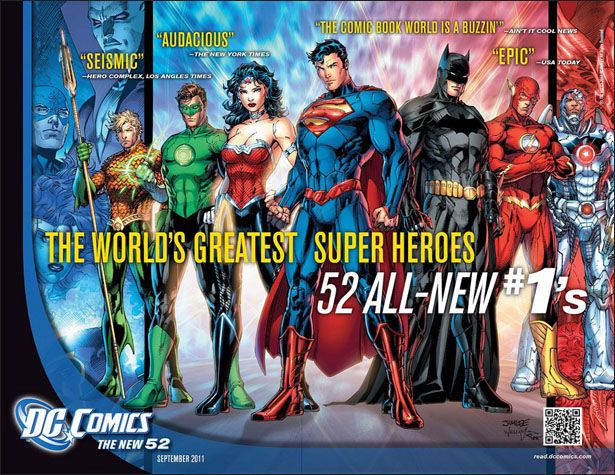This past week, DC Comics revealed the new roster for its line of superhero books. Starting in June, the publisher is debuting 24 new titles (including a handful of miniseries) to go along with 25 returning series. Because these numbers don't add up to 52 ongoing series, and because the phrase "The New 52" doesn't appear anywhere in either of DC's press releases about the roster, many comics news sites (including CBR, ComicsAlliance, and The Beat) have deemed this to be the end of the New 52 brand.
Of course, nowhere in either of DC's press releases does the publisher come out and say "we're not calling it that anymore"; but why would it? The returning series will keep their numbering (which itself goes back only to 2011); and for the most part, the revisions, reboots and relaunches which the you-know-what facilitated still seem to be intact. The recent announcements emphasize what's substantively new in the books themselves.
So why is the end of the "New 52" nomenclature worthy of a spot in Best of 7? After all, gloating is hardly in the spirit of this feature.
Well ... not to spin DC's news for it, but this makes the "New 52" label look more like a first phase than an end unto itself. When the New 52 books debuted, collectively they represented a publishing effort seen rarely, if ever, in corporate super-comics. DC had done line-wide gimmicks before, from Crisis On Infinite Earths crossovers to 1994's "Zero Month" and 2006's "One Year Later" (and Marvel had done "Heroes Reborn" on a smaller scale); but this was different. The New 52 aimed to be a true jumping-on point. In the process it sacrificed 25 years' worth of post-Crisis continuity, and in so doing took a considerable risk. That risk may not have paid off across the board, but for a while it lit a fire under DC's super-titles. (Remember when Aquaman sold better than anything from Marvel?)
The line was reorganized into groups like "The Edge" and "The Dark," it included non-super genres like swords-and-sorcery and war comics, and it helped facilitate distinctly creator-driven takes on characters like the Flash, Wonder Woman, and Batwoman. It also forced DC to commit to a more regular shipping schedule, by linking the company's print and digital efforts. Most importantly, though, it represented something bigger than the periodic tweaks which the publisher had been performing since the mid-1980s.
Before too long, though, "The New 52" was becoming shorthand for any number of bad decisions, from alienated readers and unhappy professionals to short-lived series and ugly costumes. Besides, there were the obvious criticisms -- namely, after a while it was neither "new," nor made up of 52 ongoing series. Talk of Convergence soon turned to the possibility that summer 2015 would see something different ... and now, here we are.
Accordingly, it's time to let "The New 52" -- the title, that is -- fade into the mists of comics history. It started with a bang, and it was hardly perfect, but it altered the super-comics landscape in ways which are still being felt. For all its faults, the "New 52" moniker represented a concerted, line-wide effort to reach out to readers of all kinds -- a promise to comics fans everywhere, whether DC realizes it or not, that it would produce something for each of them. This week's announcements were the latest attempts to make good on that promise, and arguably they carry greater weight because they follow what DC has tried to do under the heading of "the New 52." Although that heading may be going away, it's done its work. The promise remains.
[Editor’s note: Each Sunday, Robot 6 contributors discuss the best in comics from the last seven days — from news and announcements to a great comic that came out to something cool creators or fans have done.]

